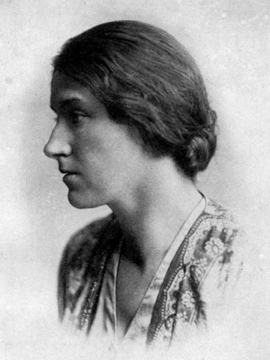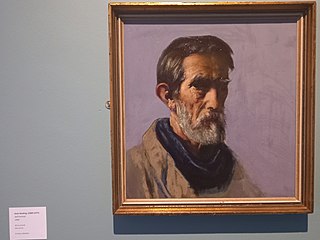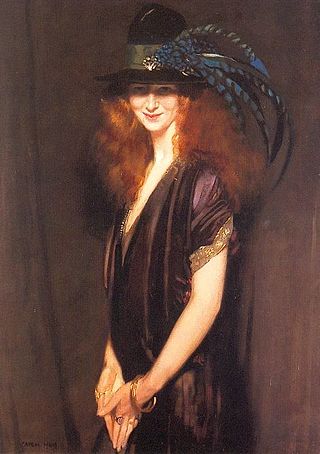
Sarah Henrietta Purser RHA was an Irish artist mainly noted for her portraiture. She was the first woman to become a full member of the Royal Hibernian Academy. She also founded and financially supported An Túr Gloine, a stained glass studio.

Mary Harriet "Mainie" Jellett was an Irish painter whose Decoration (1923) was among the first abstract paintings shown in Ireland when it was exhibited at the Society of Dublin Painters Group Show in 1923. She was a strong promoter and defender of modern art in her country, and her artworks are present in museums in Ireland. Her work was also part of the painting event in the art competition at the 1928 Summer Olympics.

Seán Keating was an Irish romantic-realist painter who painted some iconic images of the Irish War of Independence and of the early industrialization of Ireland. He spent two weeks or so each year during the late summer on the Aran Islands and his many portraits of island people depicted them as rugged heroic figures.

Christopher Whitworth Whall was a British stained-glass artist who worked from the 1880s and on into the 20th century. He is widely recognised as a leader in the Arts and Crafts movement and a key figure in the modern history of stained glass.

Cathedral of Christ the King is a Roman Catholic cathedral located in Mullingar, County Westmeath, Ireland. It is situated near the centre of Mullingar next to the Royal Canal. The cathedral is both the cathedral church of the Diocese of Meath and the principal centre of worship in the catholic parish of Mullingar, including parts of counties Meath and Westmeath.
Patrick Hickey was an Irish printmaker, painter, artist and architect who founded the Graphic Studio Dublin in 1960.

Fanny Young Cory was a cartoonist and book illustrator best known for her comic strips Sonnysayings and Little Miss Muffet. Cory was one of America's first female syndicated cartoonists.

Beatrice Moss Elvery, RHA was an Irish painter, stained-glass artist and sculptor.
Darach Ó Catháin was an Irish sean-nós singer. Along with his fellow Connemara-native, Seosamh Ó hÉanaí, he was one of the most prominent sean-nós singers of his day and was praised by Seán Ó Riada. Ó Catháin left Ireland for work and set down in Leeds, West Yorkshire where he lived out the rest of his life.
Monica Loughman is an Irish ballet dancer and teacher, writer, and television personality. She was the first Westerner to achieve solo status with the Perm State Theatre of Opera and Ballet of Russia, where she danced for 16 years. On her return to Ireland, she established a network of ballet schools. She was also featured on a television series, Ballet Chancers, and appeared in other TV shows such as The Panel, The Podge and Rodge Show, Tubridy Tonight and The Late Late Show. She is co-author of a book about her experiences.
Letitia Marion Hamilton was an Irish landscape artist and Olympic bronze medallist.
Sean Corcoran MIDI is an Irish visual artist noted for his stained glass, mosaics, wooden sculpture, and sand art.

Wilhelmina GeddesHRUA was an Irish stained glass artist who was an important figure within the Irish Arts and Crafts movement and also the twentieth century British stained glass revival. Notable works include windows at St Bartholomew's, St Peter's Church, and the King Albert Memorial Window, St Martin's Cathedral.
Patrick Pollen was a British stained-glass artist who spent most of his life working in Ireland.
Kathleen Fox was an Irish painter, enamellist, and stained-glass artist.
Kathleen Mabel Bridle ARUA was a British artist and teacher. She influenced Northern Irish artists such as William Scott and T.P. Flanagan.
Bea Orpen HRHA was an Irish landscape and portrait painter and teacher. She aided in the establishment of the Drogheda Municipal Gallery of Art.
Shevawn Lynam was an Irish novelist and journalist. She was the Spanish-language specialist with the BBC and Ministry of Information during World War II.
Sinéad Ní Uallacháin is an Irish journalist, actress, artist, podcaster, continuity announcer and radio presenter.
Philip and Barry Castle were British and Irish artists. They are considered a pair, as they are in the National Irish Visual Arts Library catalogue, as they worked and exhibited together and shared a painting technique that Philip taught Barry, which concentrated on making the colour look luminous. The Irish Times said of their partnership that "As husband and wife they have lived together a long time, but their artistic partnership spans almost as many years." They use the quattrocento style, building up the painting layer by layer.







